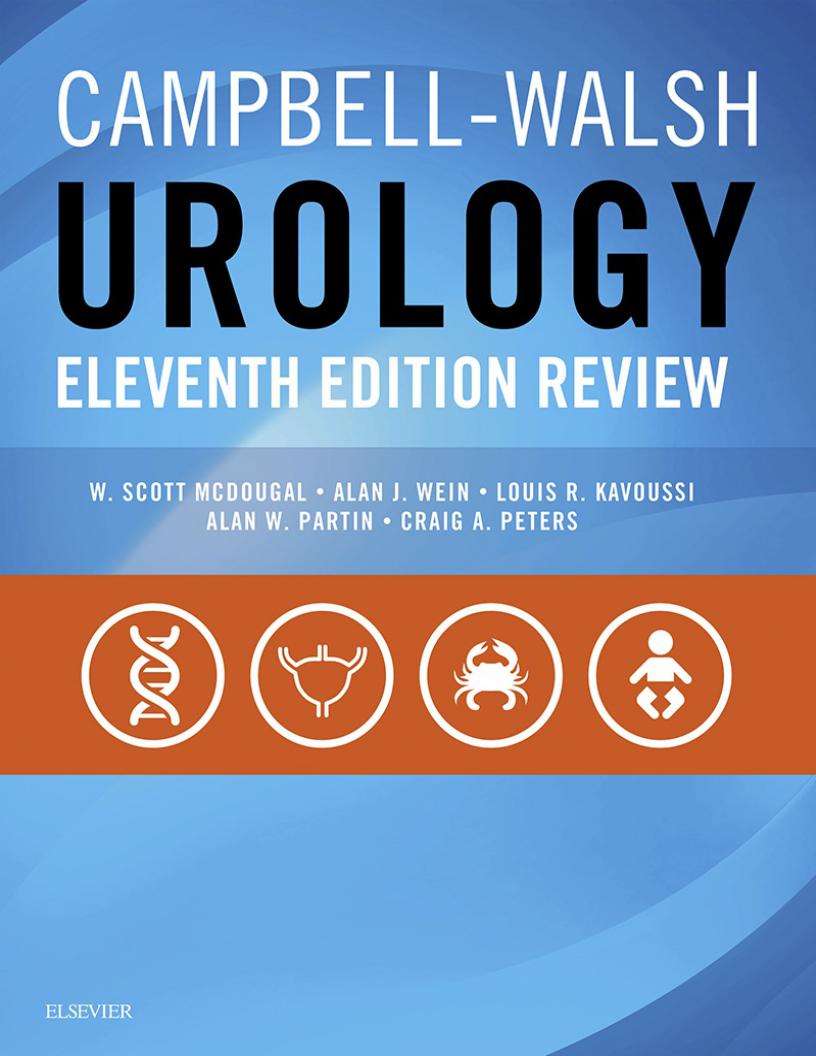
- •Table of Contents
- •Copyright
- •Contributors
- •How to Use this Study Guide
- •Questions
- •Answers
- •Questions
- •Answers
- •Questions
- •Answers
- •4: Outcomes Research
- •Questions
- •Answers
- •5: Core Principles of Perioperative Care
- •Questions
- •Answers
- •Questions
- •Answers
- •7: Principles of Urologic Endoscopy
- •Questions
- •Answers
- •8: Percutaneous Approaches to the Upper Urinary Tract Collecting System
- •Questions
- •Answers
- •Questions
- •Answers
- •Questions
- •Answers
- •Questions
- •Answers
- •12: Infections of the Urinary Tract
- •Questions
- •Answers
- •Questions
- •Answers
- •Questions
- •Answers
- •15: Sexually Transmitted Diseases
- •Questions
- •Answers
- •Questions
- •Answers
- •Questions
- •Answers
- •Questions
- •Answers
- •Questions
- •Answers
- •20: Principles of Tissue Engineering
- •Questions
- •Answers
- •Questions
- •Answers
- •22: Male Reproductive Physiology
- •Questions
- •Answers
- •Questions
- •Answers
- •24: Male Infertility
- •Questions
- •Answers
- •Questions
- •Answers
- •Questions
- •Answers
- •Questions
- •Answers
- •28: Priapism
- •Questions
- •Answers
- •Questions
- •Answers
- •30: Surgery for Erectile Dysfunction
- •Questions
- •Answers
- •Questions
- •Answers
- •Questions
- •Answers
- •Questions
- •Answers
- •34: Neoplasms of the Testis
- •Questions
- •Answers
- •35: Surgery of Testicular Tumors
- •Questions
- •Answers
- •36: Laparoscopic and Robotic-Assisted Retroperitoneal Lymphadenectomy for Testicular Tumors
- •Questions
- •Answers
- •37: Tumors of the Penis
- •Questions
- •Answers
- •38: Tumors of the Urethra
- •Questions
- •Answers
- •39: Inguinal Node Dissection
- •Questions
- •Answers
- •40: Surgery of the Penis and Urethra
- •Questions
- •Answers
- •Questions
- •Answers
- •Questions
- •Answers
- •Questions
- •Answers
- •Questions
- •Answers
- •Questions
- •Answers
- •Questions
- •Answers
- •47: Renal Transplantation
- •Questions
- •Answers
- •Questions
- •Answers
- •Questions
- •Answers
- •50: Upper Urinary Tract Trauma
- •Questions
- •Answers
- •Questions
- •Answers
- •Questions
- •Answers
- •53: Strategies for Nonmedical Management of Upper Urinary Tract Calculi
- •Questions
- •Answers
- •54: Surgical Management for Upper Urinary Tract Calculi
- •Questions
- •Answers
- •55: Lower Urinary Tract Calculi
- •Questions
- •Answers
- •56: Benign Renal Tumors
- •Questions
- •Answers
- •57: Malignant Renal Tumors
- •Questions
- •Answers
- •Questions
- •Answers
- •59: Retroperitoneal Tumors
- •Questions
- •Answers
- •60: Open Surgery of the Kidney
- •Questions
- •Answers
- •Questions
- •Answers
- •62: Nonsurgical Focal Therapy for Renal Tumors
- •Questions
- •Answers
- •Questions
- •Answers
- •Questions
- •Answers
- •Questions
- •Answers
- •66: Surgery of the Adrenal Glands
- •Questions
- •Answers
- •Questions
- •Answers
- •Questions
- •Answers
- •Questions
- •Answers
- •Questions
- •Answers
- •71: Evaluation and Management of Women with Urinary Incontinence and Pelvic Prolapse
- •Questions
- •Answers
- •72: Evaluation and Management of Men with Urinary Incontinence
- •Questions
- •Answers
- •Questions
- •Answers
- •Questions
- •Answers
- •Questions
- •Answers
- •76: Overactive Bladder
- •Questions
- •Answers
- •77: Underactive Detrusor
- •Questions
- •Answers
- •78: Nocturia
- •Questions
- •Answers
- •Questions
- •Answers
- •Questions
- •Answers
- •Questions
- •Answers
- •82: Retropubic Suspension Surgery for Incontinence in Women
- •Questions
- •Answers
- •83: Vaginal and Abdominal Reconstructive Surgery for Pelvic Organ Prolapse
- •Questions
- •Answers
- •Questions
- •Answers
- •85: Complications Related to the Use of Mesh and Their Repair
- •Questions
- •Answers
- •86: Injection Therapy for Urinary Incontinence
- •Questions
- •Answers
- •87: Additional Therapies for Storage and Emptying Failure
- •Questions
- •Answers
- •88: Aging and Geriatric Urology
- •Questions
- •Answers
- •89: Urinary Tract Fistulae
- •Questions
- •Answers
- •Questions
- •Answers
- •Questions
- •Answers
- •92: Tumors of the Bladder
- •Questions
- •Answers
- •Questions
- •Answers
- •Questions
- •Answers
- •95: Transurethral and Open Surgery for Bladder Cancer
- •Questions
- •Answers
- •Questions
- •Answers
- •Questions
- •Answers
- •Questions
- •Answers
- •99: Orthotopic Urinary Diversion
- •Questions
- •Answers
- •Questions
- •Answers
- •Questions
- •Answers
- •Questions
- •Answers
- •Questions
- •Answers
- •Questions
- •Answers
- •Questions
- •Answers
- •Answers
- •Questions
- •Answers
- •108: Prostate Cancer Tumor Markers
- •Questions
- •Answers
- •Questions
- •110: Pathology of Prostatic Neoplasia
- •Questions
- •Answers
- •Questions
- •Answers
- •Questions
- •Answers
- •Questions
- •Answers
- •114: Open Radical Prostatectomy
- •Questions
- •Answers
- •Questions
- •Answers
- •116: Radiation Therapy for Prostate Cancer
- •Questions
- •Answers
- •117: Focal Therapy for Prostate Cancer
- •Questions
- •Answers
- •Questions
- •Answers
- •119: Management of Biomedical Recurrence Following Definitive Therapy for Prostate Cancer
- •Questions
- •Answers
- •120: Hormone Therapy for Prostate Cancer
- •Questions
- •Answers
- •Questions
- •Answers
- •Questions
- •Answers
- •Questions
- •Answers
- •124: Perinatal Urology
- •Questions
- •Answers
- •Questions
- •Answers
- •126: Pediatric Urogenital Imaging
- •Questions
- •Answers
- •Questions
- •Answers
- •Questions
- •Answers
- •Questions
- •Answers
- •Questions
- •Answers
- •Questions
- •Answers
- •Questions
- •Answers
- •133: Surgery of the Ureter in Children
- •Questions
- •Answers
- •Questions
- •Answers
- •Questions
- •Answers
- •Questions
- •Answers
- •137: Vesicoureteral Reflux
- •Questions
- •Answers
- •138: Bladder Anomalies in Children
- •Questions
- •Answers
- •139: Exstrophy-Epispadias Complex
- •Questions
- •Answers
- •140: Prune-Belly Syndrome
- •Questions
- •Answers
- •Questions
- •Answers
- •Questions
- •Answers
- •Questions
- •Answers
- •144: Management of Defecation Disorders
- •Questions
- •Answers
- •Questions
- •Answers
- •Questions
- •Answers
- •147: Hypospadias
- •Questions
- •Answers
- •Questions
- •Answers
- •Questions
- •Answers
- •Questions
- •Answers
- •Questions
- •Answers
- •152: Adolescent and Transitional Urology
- •Questions
- •Answers
- •Questions
- •Answers
- •154: Pediatric Genitourinary Trauma
- •Answers
- •Questions
- •Answers
- •Questions
- •Answers


Campbell-Walsh Urology Eleventh
Edition Review
SECOND EDITION
W. Scott McDougal, MD, MA (HON)
Walter S. Kerr, Jr. Distinguished Professor of Urology, Harvard Medical School, Chief Emeritus, Massachusetts General Hospital, Boston, Massachusetts Alan J. Wein, MD, PhD (HON), FACS
Founders Professor of Urology, Division of Urology, Penn Medicine, Perelman School of Medicine, Chief of Urology, Division of Urology, Penn Medicine, Hospital of the University of Pennsylvania Program Director, Residency in Urology, Division of Urology, Penn Medicine, University of Pennsylvania, Health System Philadelphia, Pennsylvania Louis R. Kavoussi, MD, MBA Waldbaum-Gardner Distinguished Professor of Urology, Department of Urology, Hofstra North Shore-LIJ School of Medicine, Hampstead, New York Chairman of Urology, The Arthur Smith Institute for Urology Lake Success, New York Alan W. Partin, MD, PhD
Professor and Director of Urology, Department of Urology, The Johns Hopkins School of Medicine, Baltimore, Maryland Craig A. Peters, MD
Chief, Surgical Innovation, Principal Investigator, Sheikh Zayed Institute for Pediatric Surgical Innovation, Children's National Medical Center, Washington, DC


Table of Contents
Cover image
Title page
Copyright
Contributors
How to Use this Study Guide
Part I: Clinical Decision Making
1: Evaluation of the Urologic Patient: History, Physical Examination, and
Urinalysis
Questions
Answers
2: Urinary Tract Imaging: Basic Principles of CT, MRI, and Plain Film
Questions
Answers
3: Urinary Tract Imaging: Basic Principles of Urologic Ultrasound
Questions
Answers
4: Outcomes Research
Questions
Answers
Part II: Basics of Urologic Surgery
5: Core Principles of Perioperative Care
Questions
Answers
6: Fundamentals of Urinary Tract Drainage
Questions
Answers
7: Principles of Urologic Endoscopy
Questions
Answers
8: Percutaneous Approaches to the Upper Urinary Tract Collecting System
Questions
Answers
9: Evaluation and Management of Hematuria
Questions
Answers
10: Fundamentals of Laparoscopic and Robotic Urologic Surgery
Questions
Answers
11: Basic Energy Modalities in Urologic Surgery
Questions
Answers
Part III: Infections and Inflammation
12: Infections of the Urinary Tract
Questions
Answers
13: Inflammatory and Pain Conditions of the Male Genitourinary Tract: Prostatitis and Related Pain Conditions, Orchitis, and Epididymitis
Questions
Answers
14: Bladder Pain Syndrome (Interstitial Cystitis) and Related Disorders
Questions
Answers
15: Sexually Transmitted Diseases
Questions
Answers
16: Cutaneous Diseases of the External Genitalia
Questions
Answers
17: Tuberculosis and Parasitic Infections of the Genitourinary Tract
Questions
Answers
Part IV: Molecular and Cellular Biology
18: Basic Principles of Immunology and Immunotherapy in Urologic Oncology
Questions
Answers
19: Molecular Genetics and Cancer Biology
Questions
Answers
20: Principles of Tissue Engineering
Questions
Answers
Part V: Reproductive and Sexual Function
21: Surgical, Radiographic, and Endoscopic Anatomy of the Male Reproductive
System
Questions
Answers
22: Male Reproductive Physiology
Questions
Answers
23: Integrated Men's Health: Androgen Deficiency, Cardiovascular Risk, and Metabolic Syndrome
Questions
Answers
24: Male Infertility
Questions
Answers
25: Surgical Management of Male Infertility
Questions
Answers
26: Physiology of Penile Erection and Pathophysiology of Erectile Dysfunction
Questions
Answers
27: Evaluation and Management of Erectile Dysfunction
Questions
Answers
28: Priapism
Questions
Answers
29: Disorders of Male Orgasm and Ejaculation
Questions
Answers
30: Surgery for Erectile Dysfunction
Questions
Answers
31: Diagnosis and Management of Peyronie Disease
Questions
Answers
32: Sexual Function and Dysfunction in the Female
Questions
Answers
Part VI: Male Genitalia
33: Surgical, Radiographic, and Endoscopic Anatomy of the Retroperitoneum
Questions
Answers
34: Neoplasms of the Testis
Questions
Answers
35: Surgery of Testicular Tumors
Questions
Answers
36: Laparoscopic and Robotic-Assisted Retroperitoneal Lymphadenectomy for Testicular Tumors
Questions
Answers
37: Tumors of the Penis
Questions
Answers
38: Tumors of the Urethra
Questions
Answers
39: Inguinal Node Dissection
Questions
Answers
40: Surgery of the Penis and Urethra
Questions
Answers
41: Surgery of the Scrotum and Seminal Vesicles
Questions
Answers
Part VII: Renal Physiology and Pathophysiology
42: Surgical, Radiographic, and Endoscopic Anatomy of the Kidney and Ureter
Questions
Answers
43: Physiology and Pharmacology of the Renal Pelvis and Ureter
Questions
Answers
44: Renal Physiology and Pathophysiology
Questions
Answers
45: Renovascular Hypertension and Ischemic Nephropathy
Questions
Answers
46: Etiology, Pathogenesis, and Management of Renal Failure
Questions
Answers
47: Renal Transplantation
Questions
Answers
Part VIII: Upper Urinary Tract Obstruction and Trauma
48: Pathophysiology of Urinary Tract Obstruction
Questions
Answers
49: Management of Upper Urinary Tract Obstruction
Questions
Answers
50: Upper Urinary Tract Trauma
Questions
Answers
Part IX: Urinary Lithiasis and Endourology
51: Urinary Lithiasis: Etiology, Epidemiology, and Pathogenesis
Questions
Answers
52: Evaluation and Medical Management of Urinary Lithiasis
Questions
Answers
53: Strategies for Nonmedical Management of Upper Urinary Tract Calculi
Questions
Answers
54: Surgical Management for Upper Urinary Tract Calculi
Questions
Answers
55: Lower Urinary Tract Calculi
Questions
Answers
Part X: Neoplasms of the Upper Urinary Tract
56: Benign Renal Tumors
Questions
Answers
57: Malignant Renal Tumors
Questions
Answers
58: Urothelial Tumors of the Upper Urinary Tract and Ureter
Questions
Answers
59: Retroperitoneal Tumors
Questions
Answers
60: Open Surgery of the Kidney
Questions
Answers
61: Laparoscopic and Robotic Surgery of the Kidney
Questions
Answers
62: Nonsurgical Focal Therapy for Renal Tumors
Questions
Answers
63: Treatment of Advanced Renal Cell Carcinoma
Questions
Answers
Part XI: The Adrenals
64: Surgical and Radiologic Anatomy of the Adrenals
Questions
Answers
65: Pathophysiology, Evaluation, and Medical Management of Adrenal
Disorders
Questions
Answers
66: Surgery of the Adrenal Glands
Questions
Answers
Part XII: Urine Transport, Storage, and Emptying
67: Surgical, Radiographic, and Endoscopic Anatomy of the Female Pelvis
Questions
Answers
68: Surgical, Radiographic, and Endoscopic Anatomy of the Male Pelvis
Questions
Answers
69: Physiology and Pharmacology of the Bladder and Urethra
Questions
Answers
70: Pathophysiology and Classification of Lower Urinary Tract Dysfunction:
Overview
Questions
Answers
71: Evaluation and Management of Women with Urinary Incontinence and Pelvic Prolapse
Questions
Answers
72: Evaluation and Management of Men with Urinary Incontinence
Questions
Answers
73: Urodynamic and Video-Urodynamic Evaluation of the Lower Urinary Tract
Questions
Answers
74: Urinary Incontinence and Pelvic Prolapse: Epidemiology and
Pathophysiology
Questions
Answers
75: Neuromuscular Dysfunction of the Lower Urinary Tract
Questions
Answers
76: Overactive Bladder
Questions
Answers
77: Underactive Detrusor
Questions
Answers
78: Nocturia
Questions
Answers
79: Pharmacologic Management of Lower Urinary Tract Storage and Emptying
Failure
Questions
Answers
80: Conservative Management of Urinary Incontinence: Behavioral and Pelvic Floor Therapy, Urethral and Pelvic Devices
Questions
Answers
81: Electrical Stimulation and Neuromodulation in Storage and Emptying
Failure
Questions
Answers
82: Retropubic Suspension Surgery for Incontinence in Women
Questions
Answers
83: Vaginal and Abdominal Reconstructive Surgery for Pelvic Organ Prolapse
Questions
Answers
84: Slings: Autologous, Biologic, Synthetic, and Midurethral
Questions
Answers
85: Complications Related to the Use of Mesh and Their Repair
Questions
Answers
86: Injection Therapy for Urinary Incontinence
Questions
Answers
87: Additional Therapies for Storage and Emptying Failure
Questions
Answers
88: Aging and Geriatric Urology
Questions
Answers
89: Urinary Tract Fistulae
Questions
Answers
90: Bladder and Female Urethral Diverticula
Questions
Answers
91: Surgical Procedures for Sphincteric Incontinence in the Male: The Artificial Urinary Sphincter and Perineal Sling Procedures
Questions
Answers
Part XIII: Benign and Malignant Bladder Disorders
92: Tumors of the Bladder
Questions
Answers
93: Non–Muscle-Invasive Bladder Cancer (TA, T1, and CIS)
Questions
Answers
94: Management of Invasive and Metastatic Bladder Cancer
Questions
Answers
95: Transurethral and Open Surgery for Bladder Cancer
Questions
Answers
96: Robotic and Laparoscopic Bladder Surgery
Questions
Answers
97: Use of Intestinal Segments in Urinary Diversion
Questions
Answers
98: Cutaneous Continent Urinary Diversion
Questions
Answers
99: Orthotopic Urinary Diversion
Questions
Answers
100: Minimally Invasive Urinary Diversion
Questions
Answers
101: Genital and Lower Urinary Tract Trauma
Questions
Answers
Part XIV: Prostate
102: Development, Molecular Biology, and Physiology of the Prostate
Questions
Answers
103: Benign Prostatic Hyperplasia: Etiology, Pathophysiology, Epidemiology,
and Natural History
Questions
Answers
104: Evaluation and Nonsurgical Management of Benign Prostatic Hyperplasia
Questions
Answers
105: Minimally Invasive and Endoscopic Management of Benign Prostatic
Hyperplasia
Questions
Answers
106: Simple Prostatectomy: Open and Robot-Assisted Laparoscopic Approaches
Answers
107: Epidemiology, Etiology, and Prevention of Prostate Cancer
Questions
Answers
108: Prostate Cancer Tumor Markers
Questions
Answers
109: Prostate Biopsy: Techniques and Imaging
Questions
110: Pathology of Prostatic Neoplasia
Questions
Answers
111: Diagnosis and Staging of Prostate Cancer
Questions
Answers
112: Management of Localized Prostate Cancer
Questions
Answers
113: Active Surveillance of Prostate Cancer
Questions
Answers
114: Open Radical Prostatectomy
Questions
Answers
115: Laparoscopic and Robotic-Assisted Radical Prostatectomy and Pelvic
Lymphadenectomy
Questions
Answers
116: Radiation Therapy for Prostate Cancer
Questions
Answers
117: Focal Therapy for Prostate Cancer
Questions
Answers
118: Treatment of Locally Advanced Prostate Cancer
Questions
Answers
119: Management of Biomedical Recurrence Following Definitive Therapy for Prostate Cancer
Questions
Answers
120: Hormone Therapy for Prostate Cancer
Questions

Answers
121: Treatment of Castration-Resistant Prostate Cancer
Questions
Answers
Part XV: Pediatric Urology
Section A: Development and Prenatal Urology
122: Embryology of the Genitourinary Tract
Questions
Answers
123: Renal Functional Development in Children
Questions
Answers
124: Perinatal Urology
Questions
Answers
Section B: Basic Principles
125: Evaluation of the Pediatric Urology Patient
Questions
Answers

126: Pediatric Urogenital Imaging
Questions
Answers
127: Infection and Inflammation of the Pediatric Genitourinary Tract
Questions
Answers
128: Core Principles of Perioperative Management in Children
Questions
Answers
129: Principles of Laparoscopic and Robotic Surgery in Children
Questions
Answers
Section C: Upper Urinary Tract Conditions
130: Anomalies of the Upper Urinary Tract
Questions
Answers
131: Renal Dysgenesis and Cystic Disease of the Kidney
Questions
Answers
132: Congenital Urinary Obstruction: Pathophysiology

Questions
Answers
133: Surgery of the Ureter in Children
Questions
Answers
134: Ectopic Ureter, Ureterocele, and Ureteral Anomalies
Questions
Answers
135: Surgical Management of Pediatric Stone Disease
Questions
Answers
Section D: Lower Urinary Tract Conditions
136: Development and Assessment of Lower Urinary Tract Function in Children
Questions
Answers
137: Vesicoureteral Reflux
Questions
Answers
138: Bladder Anomalies in Children
Questions
Answers
139: Exstrophy-Epispadias Complex
Questions
Answers
140: Prune-Belly Syndrome
Questions
Answers
141: Posterior Urethral Valves and Urethral Anomalies
Questions
Answers
142: Neuromuscular Dysfunction of the Lower Urinary Tract in Children
Questions
Answers
143: Functional Disorders of the Lower Urinary Tract in Children
Questions
Answers
144: Management of Defecation Disorders
Questions
Answers
145: Lower Urinary Tract Reconstruction in Children
Questions

Answers
Section E: Genitalia
146: Management of Abnormalities of the External Genitalia in Boys
Questions
Answers
147: Hypospadias
Questions
Answers
148: Etiology, Diagnosis, and Management of Undescended Testis
Questions
Answers
149: Management of Abnormalities of the Genitalia in Girls
Questions
Answers
150: Disorders of Sexual Development: Etiology, Evaluation, and Medical
Management
Questions
Answers
Section F: Reconstruction and Trauma

151: Surgical Management of Disorders of Sexual Development and Cloacal and Anorectal Malformations
Questions
Answers
152: Adolescent and Transitional Urology
Questions
Answers
153: Urologic Considerations in Pediatric Renal Transplantation
Questions
Answers
154: Pediatric Genitourinary Trauma
Answers
Section G: Oncology
155: Pediatric Urologic Oncology: Renal and Adrenal
Questions
Answers
156: Pediatric Urologic Oncology: Bladder and Testis
Questions
Answers
